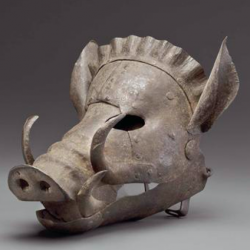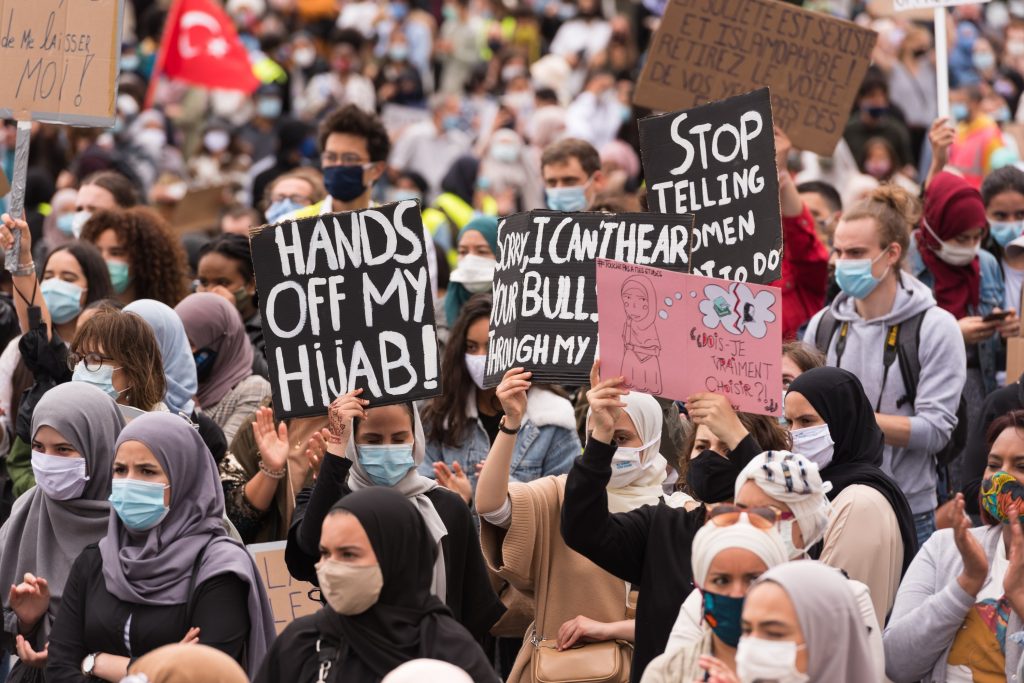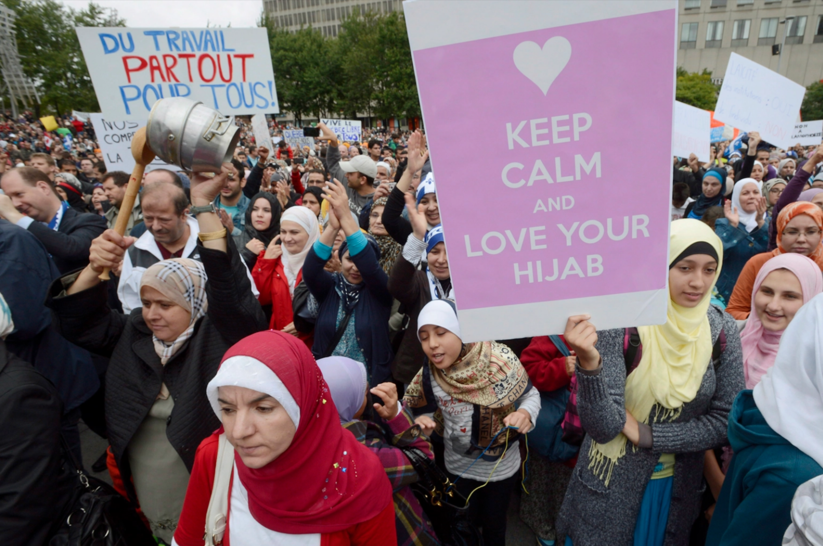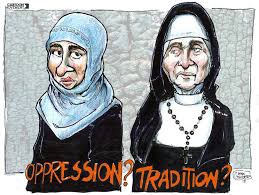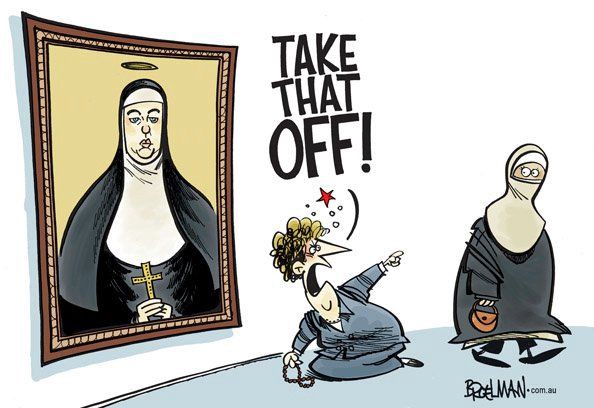Veiling and the Hijab:
Veiling is the practice of covering some or most of the body with a garment. Women from all over the world and of varying religions veil. Oftentimes the term hijab is used to refer any covering of the hair, head, face or body. Muslim women typically wear hijab when in the presence of a male outside of their immediate family. Below you can see an illustration that depicts many of the types veils worn.
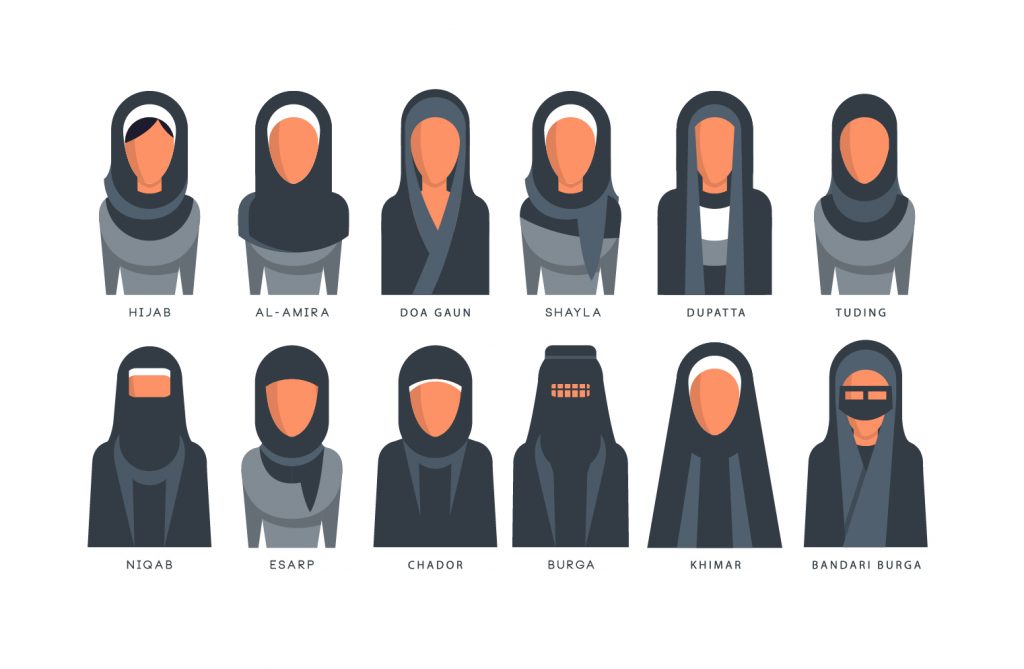
There are many different interpretations of the Quran which are used to debate whether or not women should be veiled and why. Many people who are not familiar with the practice of veiling believe that the primary purpose is to protect these women from the sexual desires of other people. Although this may be a small part of the practice there are many other reasons why women veil (Sylaj, 2020). After exploring some resources I discovered that some of these reasons include wanting to be valued as a human outside of their sexuality, making them feel powerful, showing cultural pride and so many more beautiful reasons. Veiling is constantly hit with criticism and has become a tradition that is oftentimes seen as controversial, when it just clothing. In this blog I will explore how veils began to overlap with fashion, how veiling fits into modern day politics, and the fetishization of veiling.
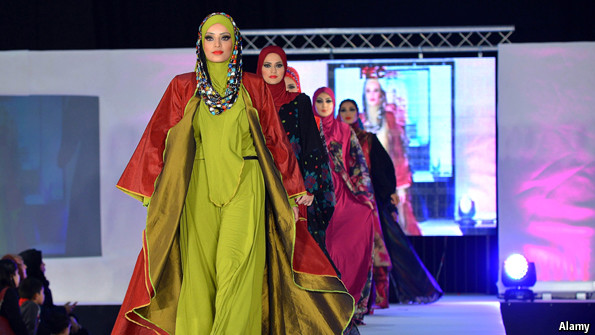
Veils as Fashion; Modernity and Turkey:
As Western development increased women began venture outside of the home to purchase goods. As this occurred veils became increasingly more visible to outsiders who may not have been so familiar with this practice (Shirazi & Mishra, 2010). Women leaving their homes to shop at department stores unaccompanied was a large part of modernization in the Middle East (Shirazi & Mishra, 2010). Quickly this lead to the shift in fashion trends especially when it came to veils. Women began to control the market more than they ever had and explore new “trendy” veils. For example, in the early 20th century as we see women adopting more form fitting clothing we see Muslim women abandoning their loose fitting veils and adopt a tighter head covering.
Oftentimes those who don’t veil perceive veiling to be a practice that goes against modernity when it comes to religious beliefs as well as fashion (Shirazi & Mishra, 2010). In reality we see that veiling is not meant to contrast or to push modernity away and instead this practice can easily be intertwined. Modernity has been very secular and it was widely understood that veiling would not be globally recognized as acceptable and that women would be expected to abandon the veil as a step towards western secularization. With this we can see that due to outsiders perception of the veil there is an expectation to abandon religious practice to fit into society.
Veils were designed to be looked at, even though the idea of veiling was to deter the gaze, because women are wearing these garments in public. Veiling in fashion became an interesting topic because the hijab was a traditionally “bland” garment and it was being combined with fashion which is known for breaking barriers and self-expression (Gokariksel, 2014). Many people couldn’t understand fashion and veils as one cohesive idea and when veiling clashes with fashion we see new patterns and exciting colors along with different fabrics and so on.
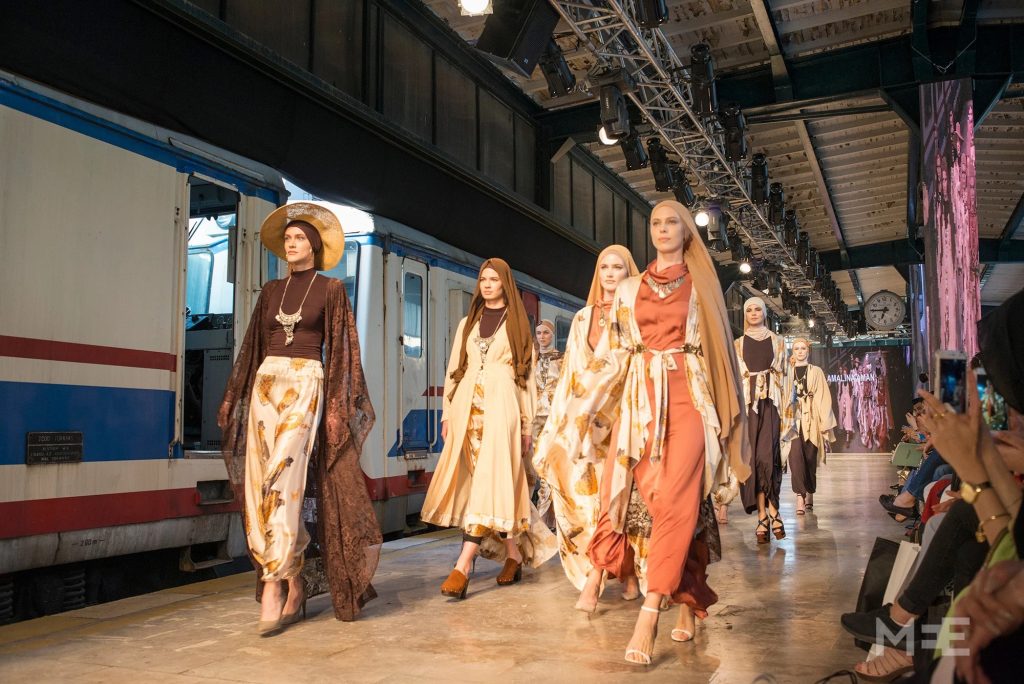
Turkey is one of the many places known repurposing the veil to be included in the fashion industry. The people of Turkey began to reject the idea that veiling is a costume or ethnic attire and we see women who veil begin to portray both social and cultural significance in what they choose to wear (Gokariksel, 2014). Women begin to wear designer veils and others are judged for wearing veils that are no longer fashionable similar to the fashion scene in the United States (Gokariksel, 2014). By observing what some women are wearing we can see the struggle that many Muslim women have when trying to find the balance between fashion and modesty. Women still wanted to veil for religious reasons and stay true to their beliefs, but sometimes they got so caught up in the fashion aspect that their veils became less modest. Above, models are shown walking at a fashion show in Istanbul where modernity and high-end fashion became a large aspect of the women of Turkey’s lives. You can see the models dressed in modest yet fashionable high-end Gucci clothing. At this show the audience members were observed wearing trendy veils, expensive jewelry, and using the newest smartphones further demonstrating the modern lifestyle that was being adopted.
Veils in Modern day Politics and Religion:
Arabs, Muslims, and South Asians have been the primary targets of the U.S. government’s global War on Terror since the September 11, 2001 attacks (Cainkar & Maira, 2005). In the United States we have seen an incredible increase in Islamophobia and attacks on people who belong to these ethnic groups. After the 2005 bombing of London hate crimes against women who were veiling increased greatly (Lewis, 2007). After seeing this occur the government suggested that women stop veiling to prevent public assault (Lewis, 2007). This idea that people should completely abandon their practices so that they can avoid abuse due to their religious beliefs is not acceptable. People should be able to practice their religion without worrying about being stereotyped as a terrorist and assaulted as a result of a recent bombing that had nothing to do with them. I have seen the suppression of people who veil in my life. There have been a few bombings and attacks in my lifetime preformed by people of varying backgrounds, yet as soon as the tredgedy occurs I start to hear terrible things about what people are assuming about the event. I oftentimes hear people assuming that the bombing was done by a Muslim person, that muslim people are terrorists and so many more hurtful comments.
Many leaders and politicians have expressed negative views of veiling which practically allows citizens to carry an Islamophobic attitude instead of allowing people to practice their religion in whatever way they see fit (Shirazi & Mishra, 2010). For example, Dr Muhammad Abdul Bari, the leader of the Muslim Council of Britain explains that women should not feel the need to veil and instead should just dress modestly, which reinforces the idea that there should be restrictions on religious practice (Shirazi & Mishra, 2010). People of various countries have been told that they cannot practice veiling by their government which eliminates a right to religion and it is important that this comes to an end. Instead of forbidding religion we need those who are not tolerant of people who veil to understand it and what a hijab really means. It should not be any more threatening than what Christian nuns wear.
The cartoons above show the idea that many Western people are comfortable with nuns wearing their habit, but not comfortable with women who veil. Why are Muslim hijabs associated with terrorism and violence while Christian habits are associated with modesty and religious devotion? (Elkawa, 2019). We know that both practices are of similar intent and based on religion so why is one of them seen as threatening while the other is seen as a tradition?
Fetishization and Misunderstanding of Veiling:
One may think that women who practice veiling would have a much lower chance of being fetishized, objectified, or harassed due to their body and desires of men, but this is often not the case. One article rejects the idea that women are hidden and the male gaze is blocked as a result of the use of veils, but instead they are not only visible, but able to see as well (Gokariksel, 2014). When women dress nicely, men stare even when women are veiled. Gökariksel and Secor explain that they spoke to women who veil and all of them expressed that the practice is not meant to bring attention to them, yet it does. When we see fashion and veiling intertwine we must discuss the gaze and what this means for women who are veiling for modesty. Women are still catcalled and harassed and the veil is actually fetishized more than you might expect. Men have been reported saying things such as “I’m interested in seeing what’s underneath” which demonstrates that they are specifically fetishizing the veil by exclaiming that they have the desire take it off of the woman and explore what he is not allowed to explore (Gokariksel, 2014). Many of the women interviewed seemed to dismiss terrible encounters like this one because they have been fairly common. The veil is not used for the pleasure of men and women should not feel uncomfortable with their religious traditions.
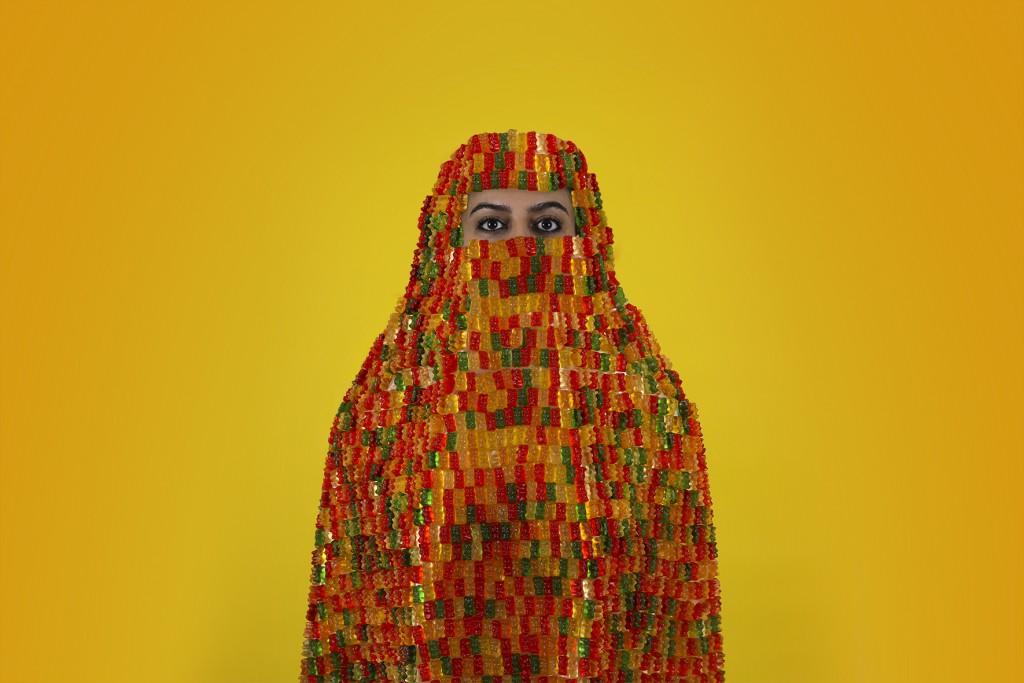
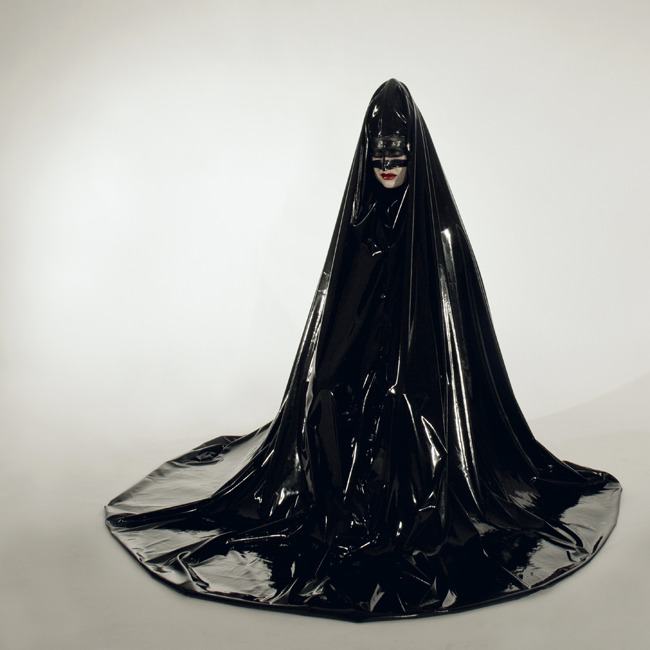
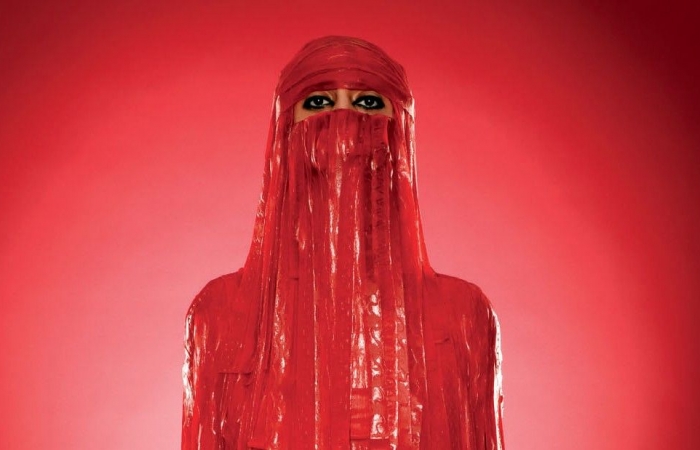
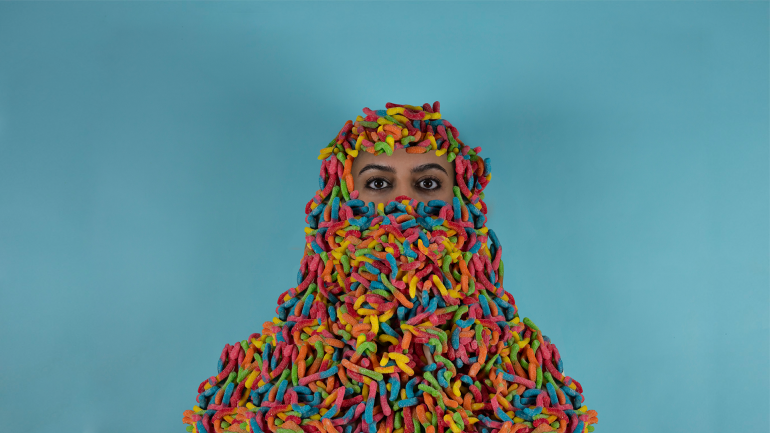
Images from Behnaz Babazadeh’s series on the Burka titled Burkaphilia
In 2012 artist Behnaz Babazadeh created a series of images and a short film titled Burkaphilia. The series portrays the common misconceptions of veiling, her understanding of the fetishization of the Burka and the ignorance that Western people typically hold in regards to her cultural practices (Rogers & Houghton, 2017). Babazadeh explains that when she came to the U.S from Afghanistan as a young girl she was obsessed with the candy which provided her with the content for the images (Tucker, 2016). In these images she allows candy to take the form of a burka over her body to imply the American obsession with consumption and sexualization. Her goal when creating these elaborate burkas was to challenge people’s misconceptions about veiling and make the audience truly think about what makes a burka so threatening to those who don’t practice veiling (Tucker, 2016). Is the veil still so ominous when it is made of gummy bears?
In the video Babazadeh displays herself in a latex burka. We see her fully veiled body with only her eyes showing as the camera zooms into her face, shortly after we can see a man approach her with a cake and as he cuts into the cake she reveals her mouth to take a bite, then the man begins to lick up her latex burka. By showing this series over events she expresses the idea of fetishization of women who veil and the Western obsession with consumption, food, and sex. The film “explores the cultural practice of arranged marriages, sex and taboo in ancient Middle Eastern custom through modern Western metaphors of food and fetishism” (Babazadeh, 2019). The film is linked below if you would like to view it.
Concluding Remarks
Veiling is the practice of covering part or all of your body with a garment and is typically seen by Muslim women. It is a religious tradition that has oftentimes been given a negative connotation by Western people. People who veil have been classified as dangerous terrorists or their tradition is fetishized as men express the desire to see whats underneath and discover what these women are keeping private. Through educating individuals we can see that veiling is a practice that can fit into modernity if people will accept it simply as a religious tradition and as fashion. Veils are beautiful, not dangerous or ominous, and definitely not for men to fetishize.
Works Cited:
Babazadeh, B. (2019, March 7). Burkaphilia: Short Art Film. Vimeo. https://vimeo.com/40595706.
Cainkar, L., & Maira, S. (2005). Targeting Arab/Muslim/South Asian Americans: Criminalization and Cultural Citizenship. Amerasia, 31(3).
Elkawa, A. (2019, October 6). Habit v. Hijab. Medium. https://medium.com/@elkawa/habit-v-hijab-e2e846020428.
Gokariksel, B. (2014). The Veil, Desire, and the Gaze: Turning the Inside Out. In 1311289662 964013388 A. Secor (Author), Signs Journal of Women in Culture and Society (1st ed., Vol. 40, pp. 177-200). Chicago, IL: University Of Chicago Press.
Rogers, F., & Houghton, M. (2017, August 22). Behnaz Babazadeh’s candy burqas challenge cultural stereotypes. CNN. https://www.cnn.com/style/article/behnaz-babazadeh-edible-burqa-photography/index.html.
Sylaj, H. (2020, October 15). Why do Muslim women wear hijab? Retrieved April 06, 2021, from https://medium.com/interfaith-now/why-do-muslim-women-wear-hijab-8d0cd811e2b1
Shirazi, F., & Mishra, S. (2010). Young Muslim women on the FACE Veil (niqab). International Journal of Cultural Studies, 13(1), 43-62. doi:10.1177/1367877909348538Lewis, R. (2007). Veils and Sales: Muslims and the spaces of Postcolonial fashion retail. Fashion Theory,11(4), 423-441. doi:10.2752/175174107×250235
Tucker, F. (2016, January 29). Burkaphilia. Actipedia. https://actipedia.org/project/burkaphilia.
Why do some women wear a hijab? (n.d.). Retrieved April 06, 2021, from https://wonderopolis.org/wonder/why-do-some-women-wear-a-hijab
